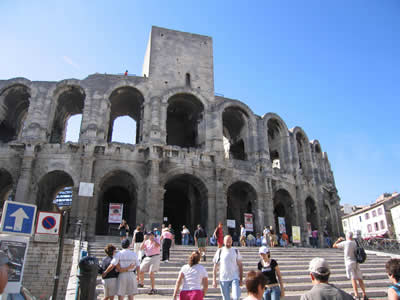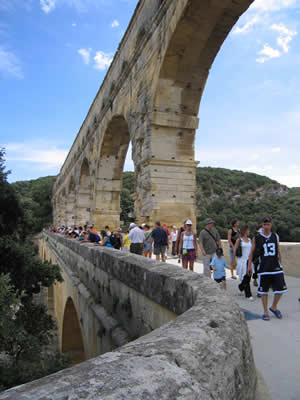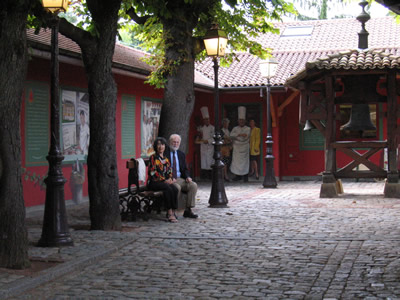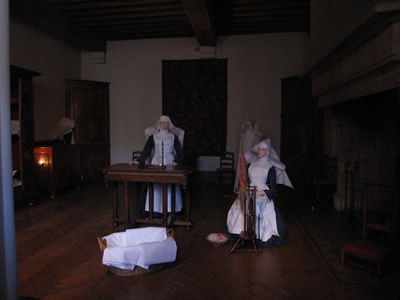 |
|
|
|
|
|
|
|
|
|
|
|
|
|
|
|
|
|
|
|
|
|
|
 |
 |
|
|
|
|
|
|
|
|
|
|
|
|

|
Connoisseur’s Provence and Burgundy Cruising the Rhone and Saone Rivers The Romans thought so little of their newly conquered land in Gaul that they dismissively named it Provincia, the province. But Provincia evolved into Provence, a land for everyone’s heart and imagination, not strictly a geographic entity or officially a department, but to a greater extent, a destination. These days, Provence is even more modish, with no small thanks to Peter Mayles’ best-seller, “A Year in Provence.”
In 1486 following some turbulent centuries and invasions, this Southeastern region of what is now France fell permanently within the country’s borders, its boundaries circumscribed by nature. To the west is the Rhone; to the south, the Mediterranean; to the east, the Alps; and to the north the terrain where the olive groves end. Guidebooks often pair Provence with the Cote D’Azur, but in truth a greater symbiosis exists with Burgundy. Resplendently Gallic Burgundy suggests richness, luscious wines, memorable gastronomy, a visible history, and arresting architecture. Uniworld, a company whose boats sail the world’s waterways is of similar mind and arranged its latest itinerary, Connoisseur’s Provence and Burgundy, to dock at ports that show off the region’s best attractions. I should have known that I would fall in love with Provence, its green craggy hills and ripe grapes hanging on amber-tinted vines; its rivers that bubble and spill past red-tiled roofed villages; the light filtering through cypresses and weeping willows; the scent of lavender floating through the air; bougainvillea, oleander, and fuchsia painting the landscape; and the whole of it bathed in the sunshine that beckoned Cezanne and van Gogh to settle here.
There’s no way I can keep myself from loving a place where I get to witness the sweetness of the summer landscape that’s inviting enough to make me feel at home and exotic enough to let me know that I’m not. And so it was on a Thursday afternoon, following an overnight flight from the States, we were picked up in Marseilles and escorted to Arles to board the River Royale, the latest entry in a fleet of Uniworld boats that sail the world’s waterways. Connoisseur’s Provence and Burgundy is the newest itinerary in the company’s directory of cruises. Some areas-- places where villages are clustered close together and the attractions are near the river banks--are made for sightseeing by boat. Provence and Burgundy fit the description. The program began in earnest the next day when we were treated to an illuminating lecture illustrated with slides about “Vincent van Gogh’s troubled destiny.” To prepare for a tangible sighting of where and how he spent his days, our lecturer presented dimensions of the artist’s psyche and life. Soon we would see some of his workshops; the Cloister of St. Paul, the mental hospital where van Gogh stayed and painted some of his greatest, most tormented work. Following a restoration that retained the garden courtyard and looking exactly as it does on canvas, the hospital was turned into a cultural center. As we walked through Arles, there were other recognizable scenes painted by van Gogh; cypress trees swaying in the wind; a street near the dock where during his Japanese period, the artist painted gardens and a drawbridge; and Café du Nuit on the Place du Forum, van Gogh’s hangout, which was renamed for him. Surrounded by restaurants, the active square is so crowded with tables that passing from one side to the other is not an easy task Although Arles “the hills surrounding the marshes” was originally a Greek settlement, its significant remains date from Roman times. Passing through the walls by way of the Augustus Gate, we followed our guide to major old remnants—an arena, now used for bullfights, and a very early theater. In the Place de la Republique the clock on the Cathedral of St. Trophime chimed at precisely 11 a.m. A musician played his flute in sync with organ music that was projected into the square. The Museum Arlaten, built with the Nobel Prize money donated by the poet Frederic Mistral, exhibits typical Provencal furniture. The charm of the displays spills into the streets where wrought iron lanterns are suspended from limestone buildings.
In the Middle Ages Arles was a famous trading center. The bright-colored Provencal cotton cloth (indiennes) covered with petit patterns and fashioned into clothing and household goods were inspired by silks brought back from India.
You can view the town’s attractions aboard the open-air Le Petit Train d’Arles, leaving from the Tourist Office on the Boulevard des Lices. Most days we participated in morning and afternoon excursions. Guests sometimes had the option of returning to the boat for lunch or dining in town. Like Arles all of the ports include traces of the past. The Romans, who had been in the area for about 600 years, left behind vestiges of their presence. One afternoon we visited what was perhaps their most remarkable achievement, the engineering feat involved in building the three-tiered aqueduct, Pont du Gard, which carried water from the springs of Uzes to Nimes. Finished in 52 A.D. after 17 years of work, the aqueduct was the highest one ever built by the Romans. Limestones from the local quarry weighing two to six tons were carried on goats to the building site. The Romans maintained vineyards and groves of olive trees in the seven hills around Nimes. The town of Uzes, is known for its three towers and three powers—the Bishop, Consul, and Duche. Its hub, the Place aux Herbes, an outdoor space for the market and cafes, is busy even during mid-week. Uzes is also noteworthy for its many art galleries and ownership of second homes by citizens from other countries. A visit to Avignon, a city with a very ancient center, followed. It is the place where I would have most liked to linger. The 2007 itinerary will allot more time to this port. Three miles of ramparts surround the inner city, which was home to seven popes who inhabited the magnificent Palais du Popes, the star attraction here. But what really hooked me on Avignon was a ride on Les Trains touristiques d’avignon. The city outside the ramparts looks like a miniature Paris with courtyards, hidden gardens, narrow streets, cafes, plazas, tall old trees, and branches of all the fashionable merchants that one would find in the capital. As the River Royale sailed away from the dock we sighted the renowned Pont St. Benezet, celebrated in the song, “Sur le pont du Avignon.” Twelve locks later we were in Viviers, a wind-swept, eerily haunting, well-kept medieval village perched on the peak of a crest.
At dusk Viviers was deserted, its populace of a few thousand dining behind closed shutters. Not only has the 21st century been left behind, but the 20th, 19th, 18th and so forth had, too. A town trust administers a strict building code for the preservation and restoration of the old unpainted stone houses with wooden doors. At the top of the narrow cobblestone lanes in the Cathedrale de Viviers, Jan Leonetsky, composer, pianist and organist, gave an organ recital, which included two of his own compositions. The cathedral, the smallest in France, once owned six Gobelin tapestries. All were stolen, but three have been returned. Next day we arrived in Tain L’Hermitage, home of the manufacturer of Valrhona, one of the world’s most acclaimed chocolates, and a school to teach professionals. Swans in formation, baskets of flowers suspended from double lamp posts, and church bells greeted us. I had imprecisely anticipated that the air would be fragrant with the scent of chocolate just as it is in Hershey, Pennsylvania. Perhaps the aromas were missing because it was Sunday and the factory was closed. Valrhona representatives visited the ship bringing with them toothsome samples and tips for tasting. In France where chocolate, like wine, receives an appellation,Valrhona is Grand cru. What more appropriate way is there to follow up a chocolate tasting than with a sampling of Cote de Rhone Hermitage and St. Joseph wines made from grapes that grow in the nearby valley? At the Ferraton cellar we learned about production, imbibed from Madame’s bottles and discussed the qualities that make them great. After a walking tour of Tournon sur Rhone, the River Royal set sail for a stay in We disembarked on a market day and mingled with throngs of people browsing in the dappled morning sunshine among the book and food stalls along the Saone. Some say that Lyon, rather than Paris, is France’s capital of gastronomy. The display of fresh products, especially the locally celebrated pork, supports that premise. Just north of Presqu’ile in La Croix-Rousse, one finds among the picturesque labyrinth of the old town, Vieux Lyon, the former homes of bankers and merchants who made Lyon an important commercial center in the 15th and 16th centuries. From the streets they are impressive enough, but nearly all of them hold a greater enchantment within. Every so often you notice a heavy anonymous-looking wooden door through which you enter the semi-secret world of traboules, private enclosed passageways, which allowed 18th-century silk workers to scurry between houses when Lyon was the greatest of all silk-weaving centers. In the steeply-hilled district of Fourviere stand the basilica and one of the most striking reminders of the city’s ancestry, the remains of a 10,700 seat Roman amphitheater. Dinner at l’Auberge chez, Paul Bocuse in nearby Collonges was to have been the highpoint of the Lyon visit. The three stars awarded by Michelin did not glow at our table. From the first course, viennoise of sea bream, which reminded us of gefilte fish from a jar, to a thin crème brulee, the food was ordinary. Only the petit fours and sweets shone. Wines were quite acceptable, despite having been chosen with great attention to the right side of the carte. Some might find the inn gaudy--bright murals of the history of French cooking adorn the exterior--but we thought it was decorated in fine taste, including quality table settings. Our last days were spent in Burgundy visiting three distinctive towns—Macon, Chalon sur Saone, and Beaune--crowded with opportunities for sightseeing. The great benefit of river cruising is that it offers the possibility of visiting smallish villages laden with charm and history. And we seemed to arrive at propitious moments. To celebrate a holiday the bars and restaurants in Macon teamed with activity. During the revolution anti-religious fervor was particularly strong here and led to the destruction of most of the churches. Nevertheless, a section of old paved streets “The Heritage Trail” still showcases some unique architecture, notably the Maison du Bois, a 15th-century timbered house covered with strange carvings. Two activities are not to be missed on a ramble through the antiquated center of Beaune, snug within its surrounding ramparts and boulevards. Visit the medieval gem, Hotel-Dieu, laid out around a magnificent inner courtyard and capped with geometric multi-colored Burgundian tiles. The building now houses a unique museum looking much as it did in the 15th century when an order of nuns tended the poor and sick. Next sample Burgundy’s array of wines. Buy a modestly-priced ticket for the Marche aux Vins and wind your way through a labyrinth of candlelit caves while sipping world-class wines at barrel tables. Or set out on your own through the narrow streets. Many of the open doors lead to wine shops and cellars where you are welcome to taste as much as you wish. We had cruised the rivers dipping into many centuries of history and we had done it with panache. The spic and span first-season-in-the-water boat was tastefully appointed. Room size was reasonable by river boat standards. We did not feel cramped in our cheery cabin. And the public spaces, the Cezanne Dining Room and the Renoir Lounge, were large enough to comfortably accommodate 130 passengers at one time. Watching the ship glide through the locks was the best on-board activity, especially when one was stretched out on a lounge on the open Soleil Deck. Food was pleasant and plentiful. The very affable cruise manager, and a master of organization, Christian Basel, set the stylish tone. Visiting lecturers and local guides were very knowledgeable. No one could fault the well-designed tours. No snafus under the manager’s watch. (Oh, well, that dinner at Bocuse, but he didn’t cook it). Was it Basel who arranged the glorious weather? One week was hardly enough for tasting Burgundy’s noble wines. Something tells me we’ll be back in the region. Uniworld, 17323 Ventura Blvd., Los Angeles, CA 91316. Tel. 800-733-7820. Spring 2007 |
||||||||||



